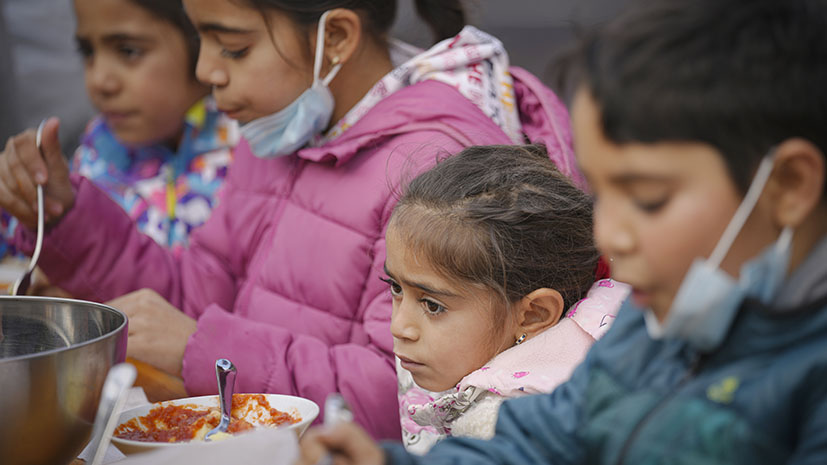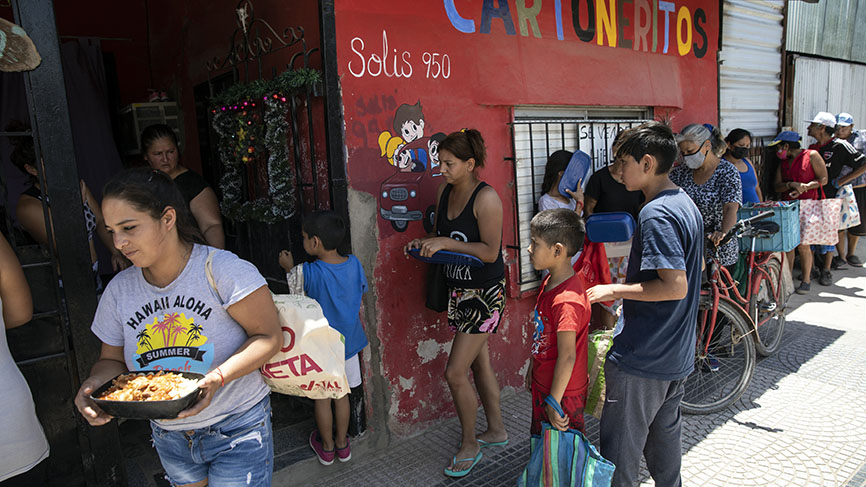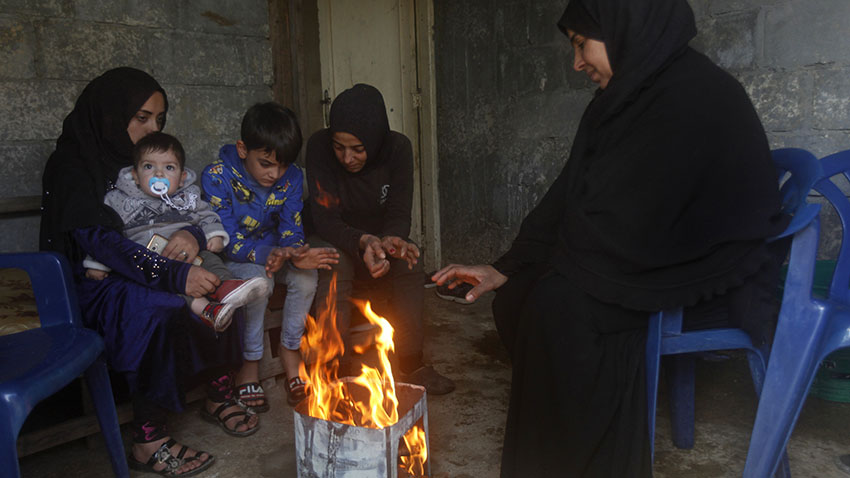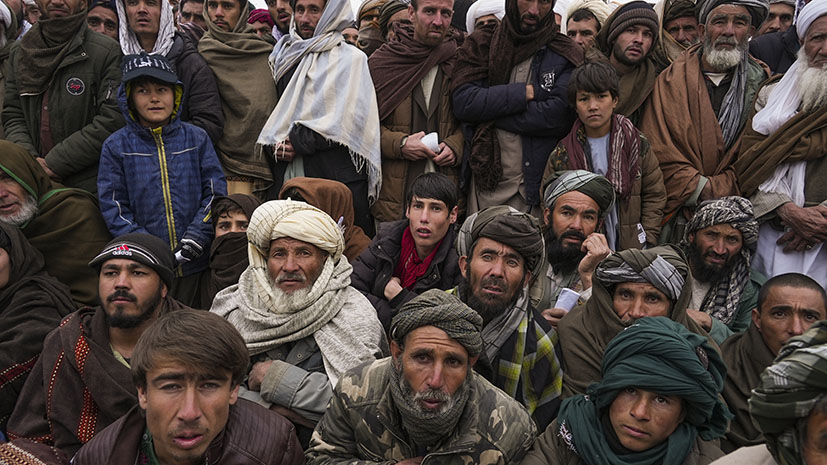The fight against poverty is one humanity has been engaged with for centuries. But before the pandemic hit in early 2020, you'd be surprised to know it was a fight we actually seem on the right path to win.
In the past few decades, the world was making great, unprecedented progress in alleviating global poverty. In the last 25 years, poverty was steadily declining, and it was doing so faster than in any other time in history, a revolution led by two countries - China and India.
But the COVID-19 outbreak has brought about unforeseen challenges, and undone much of that hard-won progress. Does that mean we will never be able to completely beat poverty?
What's poverty?
In monetary terms, poverty has a simple definition. According to the World Bank, anyone who is living on less than $1.90 a day is considered to be living in extreme poverty. There are currently 689 million people living in poverty - 9.2 percent of the global population, according to the World Bank's estimates.
As of recent times, extreme poverty has become increasingly concentrated in sub-Saharan Africa, where about 40 percent of the region's people live on less than $1.90 a day. In the Middle East and northern Africa, extreme poverty rates nearly doubled between 2015 and 2018 from 3.8 percent to 7.2 percent, amid crises and wars.
But many have argued that being poor can't really be reduced to a simple monetary equation. The simple description offered by the World Bank carries a multitude of consequences with it: people living in poverty are unable to afford basic food, clothing, health care and shelter. They often don't have access to education and they struggle to get employment.
These different faces of poverty inspired a new approach to what we now call 'multidimensional poverty:' according to the Multidimensional Poverty Global Index, the poor inlude anyone who is deprived in at least one third of ten indicators including nutrition, child mortality, years of schooling and school attendance, access to cooking fuel, sanitation, drinking water, electricity, housing and other living assets.
Under this definition, there are currently 1.3 billion people living in poverty in the world, half of whom are children. The total number of people living in poverty around the world had been steadily diminishing for the past three decades - but now this trend is being reversed by the pandemic.

A little girl pauses while eating during a Christmas event for children from poor communities in Bucharest, Romania, in December 2021. /AP Photo/Vadim Ghirda
A little girl pauses while eating during a Christmas event for children from poor communities in Bucharest, Romania, in December 2021. /AP Photo/Vadim Ghirda
'Slipping further into poverty': The impact of the pandemic
According to a World Bank report on the projected poverty impacts of the pandemic, between 71 and 100 million people were pushed into poverty in 2020 as a result of the COVID-19 crisis, with the majority of the new extreme poor being found in South Asian and sub-Saharan countries, places where poverty rates are already extremely high.
In 2021 the negative trend persisted, with over 143 million people estimated to have slipped further into poverty.
"I think in a generic and global sense, you can say without any hesitation that it is a major setback depending on where you live and what country you belong to and what kind of social protection systems were able to be mobilized," explains Achim Steiner, administrator of the United Nations Development Program.
"The impact on poverty has been differential now, clearly in the low income countries across the world, and very little the social protection exists. We have seen massive increase in poverty, also in extreme poverty, the numbers going well beyond the 100 million people who have already been thrown back into poverty in Latin America and the Caribbean, for example, the recently published a new human development report for the region. And we estimate that the setback is really taking us back 13 years to the year 2008 when we last saw these kinds of poverty levels."
Social protections measures put in place by governments during the pandemic - like furloughs - were short term, and are unlikely to cover the number of people on the edge of poverty, especially those who are struggling to re-enter the workforce.

Neighbors wait in a line for a free meal at a popular dinner spot called "Cartoneritos," on the outskirts of Buenos Aires, Argentina, in December 2021. According to INDEC national statistics bureau, poverty reached 40.6 percent in the first half of 2021. /AP Photo/Rodrigo Abd
Neighbors wait in a line for a free meal at a popular dinner spot called "Cartoneritos," on the outskirts of Buenos Aires, Argentina, in December 2021. According to INDEC national statistics bureau, poverty reached 40.6 percent in the first half of 2021. /AP Photo/Rodrigo Abd
'Digging ourselves out of a quite deep hole': Economic recovery and job loss
"2020 was the biggest crisis in the world of work in modern times," says Guy Ryder, director general of the International Labor Organization.
"The impact on jobs and incomes was about four times greater than in the financial crisis of 2008-2009. We're digging ourselves out of quite a deep hole, I'm afraid," he adds.
Ryder, who was in charge of a report that looked at how the recovery process is likely to go throughout 2022, says that "the recovery, though important, will be incomplete."
And the impact will disproportionately affect those who were already under more dire circumstances.
"We won't be back to where we started from. But perhaps even more important than that is the unevenness of this recovery. Some are going to do quite well. Others are going to have a very hard time of it."

Syrian refugees warm themselves around a fire outside their small house, in Sarafand village near the southern port city of Sidon, Lebanon, Sunday, in January. Lebanon, a country of 6 million people, is home to 1.5 million Syrians who fled the now decade-old civil war in their country. The United Nations estimates that 90% of Syrian refugee households live in extreme poverty. /AP Photo/Mohammed Zaatari
Syrian refugees warm themselves around a fire outside their small house, in Sarafand village near the southern port city of Sidon, Lebanon, Sunday, in January. Lebanon, a country of 6 million people, is home to 1.5 million Syrians who fled the now decade-old civil war in their country. The United Nations estimates that 90% of Syrian refugee households live in extreme poverty. /AP Photo/Mohammed Zaatari
READ MORE: How can we unlock opportunity for all? Find out in INNOVATION, ACTION, CHANGE our digital special on poverty causes and solutions from around the world.
Leaving women behind
Among those who are going to have a very hard time, Ryder says, are women.
Gender equity in the workforce is another sector where the pandemic has dealt a major setback: women have been losing their jobs at higher rates than men since the outbreak of the virus, they're reporting more feelings of exhaustion and burn-out than their male counterparts, and one in four women is estimated to be considering downsizing their career because of this added pressure.
The pandemic has had a negative impact on all women, even those outside of the workforce, but among those suffering the most are working mothers, women in senior management positions, and Black women.
The reason why women in the workforce have been affected more negatively than men by the pandemic is linked to the nature of the jobs women do and the expectation on women to be the main caretaker in a family setting, Ryder explains.
"Firstly, because they are segregated and concentrated in those sectors which have been hardest hit. Secondly, because often they're on relatively insecure employment contracts, so it's easier for them to be shown the door in the first instance. And thirdly, they've had to pick up those care responsibilities at home when schools close, when the kids need looking after, women invariably pick it up," he says.
"And what is worrying, I think in particular, is that nine out of every 10 women who have moved out of their jobs during the pandemic have actually left the labor force. They're not unemployed, the inactive, as the economists would say, they're simply not participating anymore."
Because they're very often underpaid (or unpaid) and undervalued, women are also the majority's of the world's poor. Living in persistent, extensive poverty also denies women the chance to build up their savings and get out of poverty.
Why is it so hard to get out of poverty?
When a child is born into a poor family, it's against all odds that they will emerge out of the poverty surrounding them. That's not pessimism, but what's known as 'the poverty trap' or 'the cycle of poverty.'
Sociologist Janet Mola Okoko has defined the poverty cycle as, "a vicious spiral of poverty and deprivation passing from one generation to the next."
This "vicious spiral" is triggered by poverty, and it's constantly reinforced by all the consequences of poverty - malnutrition, lack of education, lack of access to healthcare and shelter. This concurrence of negative circumstances makes it so that people living in poverty are unable to reach the means to escape poverty, lacking the opportunities that will get them a higher-salary job or a better home.
It is estimated that it takes at least three generations for impoverished families to lift themselves out of poverty.
But the poverty cycle is not perpetual. It can be broken - and there are examples of countries which have remarkably lifted millions out of poverty, like China.

Hundreds of Afghan men gather to apply for the humanitarian aid in Qala-e-Naw, Afghanistan in December 2021. Severe drought has dramatically worsened the already desperate situation in Afghanistan forcing thousands of people to flee their homes and live in extreme poverty. Experts predict climate change is making such events even more severe and frequent. /AP Photo/Mstyslav Chernov
Hundreds of Afghan men gather to apply for the humanitarian aid in Qala-e-Naw, Afghanistan in December 2021. Severe drought has dramatically worsened the already desperate situation in Afghanistan forcing thousands of people to flee their homes and live in extreme poverty. Experts predict climate change is making such events even more severe and frequent. /AP Photo/Mstyslav Chernov
A lesson from China
Last year, China's President Xi Jinping announced that the country had met its long-awaited goal of lifting the entire country out of extreme poverty by 2021.
Over 800 million people were lifted out of extreme poverty since a new series of economic reforms were launched in the 1970s. But the national benchmark used by the Chinese government is slightly higher than the $1.90 day poverty line used by the World Bank to look at poverty globally.
"The definition of the current poverty line was set in 2011 and is 2300 Yuan in annual disposable income per capita, which is roughly $1 a day," explains Luo Liming, a reporter from China Radio International.
"It looks like a rather modest goal, but 10 years later, now that 2,300 Yuan is worth 4,000 Yuan at the current price level. And we've already shot through that target. The per capita disposable income of the rural poor increased from 6,079 Yuan in 2013 to 12,588 Yuan, or nearly $2000 in 2020."
According to Steiner, China's success in its fight against poverty comes down to two factors.
"Priority was given to addressing not only the modernization and industrialization, which clearly became the economic engine of China's remarkable economic growth and development over the last 30 years," he says, "but from very early on, there was a strong commitment to also deal with poverty eradication and to address those who were not living in the shiny new big cities being built in the industries around the urban centers, but also to deal with those living in the rural economy and the rural areas of China.
"And leaving no one behind is something that has been integral of many of China's development policies. And so China's record in lifting people out of poverty, literally hundreds of millions of people over just two or three decades is without precedent so far."
Future challenges - and hopes
When we look at the challenges ahead in our fight against global poverty, the future looks quite threatening. Conflicts and climate change, combined with the impact of the pandemic, are likely to undermine our efforts at eradicating poverty.
Technology and innovations should be used to assist communities struggling with water shortages, droughts and floods, and to empower farmers with techniques that will provide reliable crops even in the most uncertain times.
Most importantly, wealthy countries need to step in to help lower income countries. "We really cannot leave the less developed countries to fend for themselves," says Ryder.
According to the International Monetary Fund, some $16 trillion were spent by governments around the world to handle the COVID-19 crisis, says Ryder, and yet most of this money was spent by rich countries on rich countries.
The UN estimates that eradicating extreme poverty will cost a total of $175 billion per year, which is less than one percent of the combined income of the richest countries in the world. And yet, somehow, this goal still appears out of reach.

